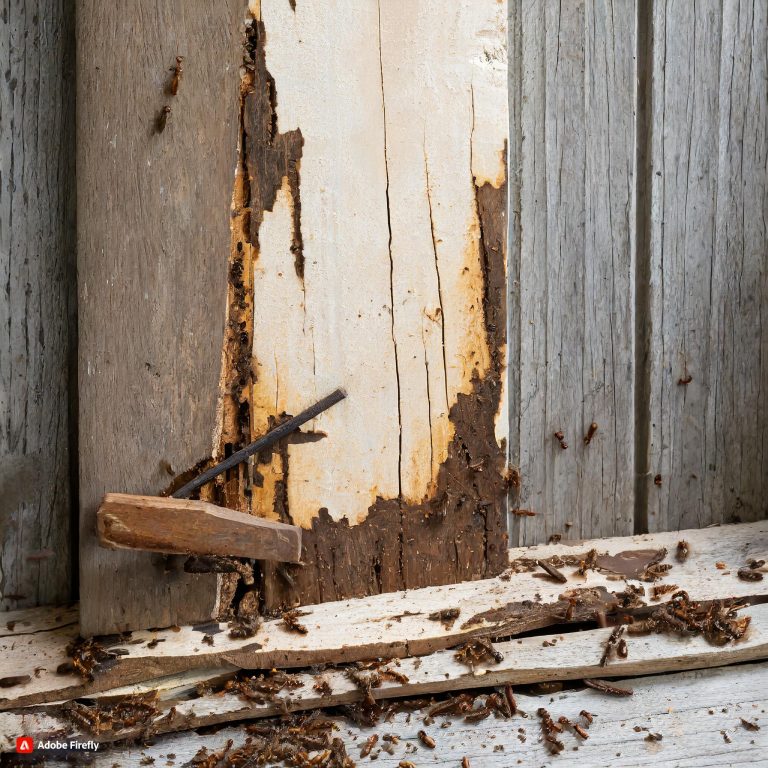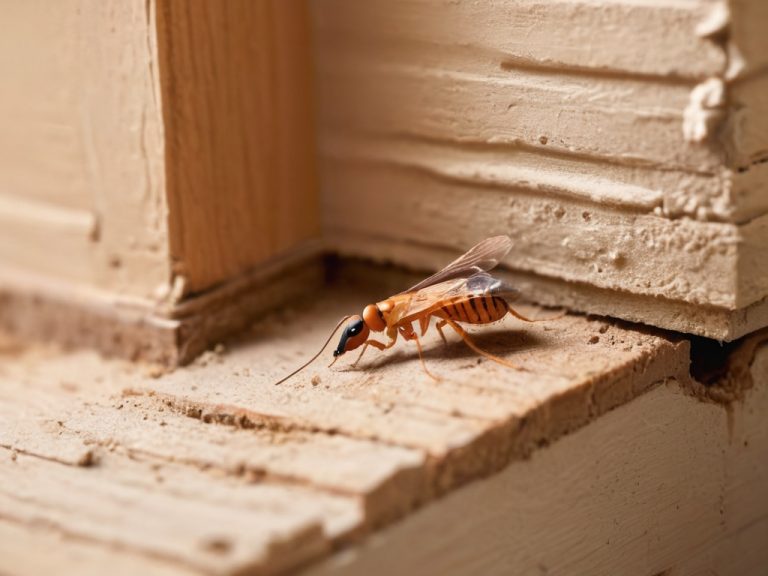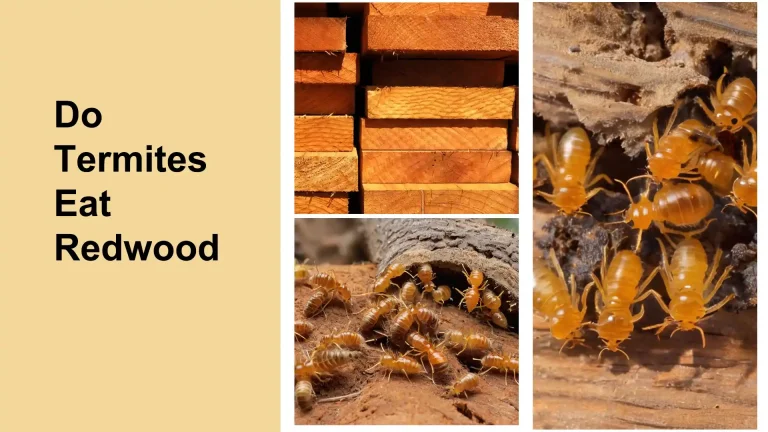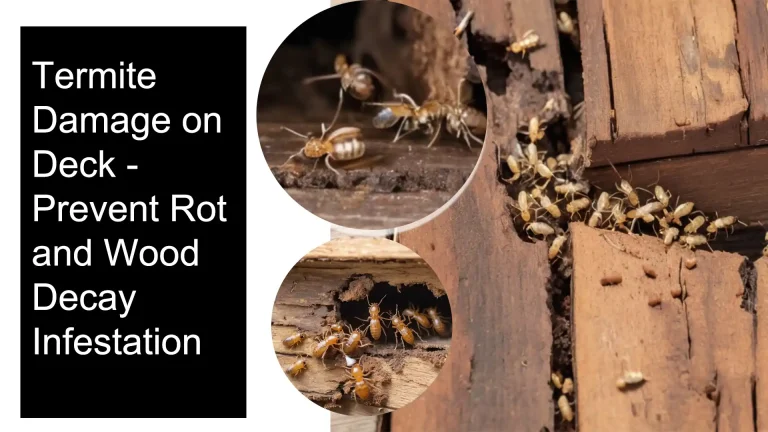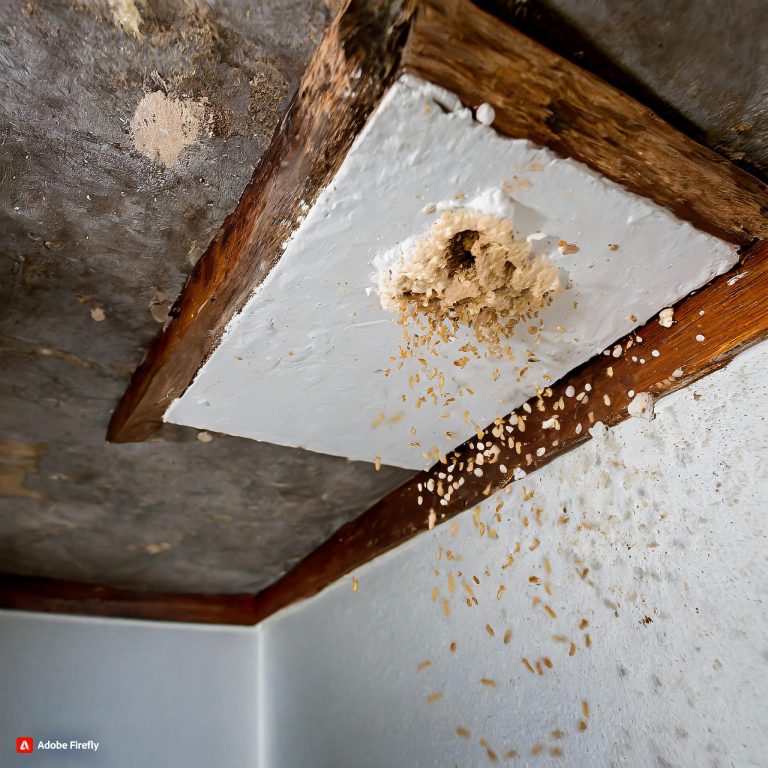Protect Your Home from Carpenter Ant Damage vs Termite Damage
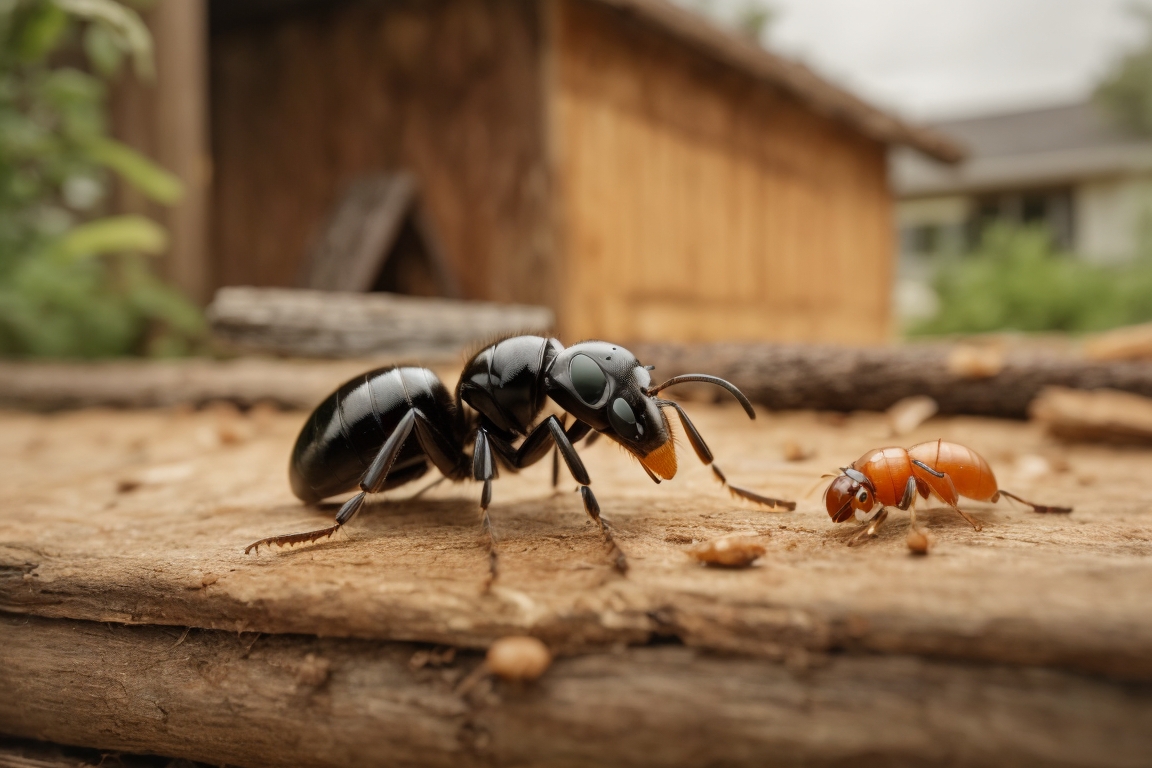
- Signs of Carpenter Ant Damage vs Termite Damage
- Preventing Carpenter Ant and Termite Destruction
- How Carpenter Ants and Termites Damage Wood
- Identifying Carpenter Ants vs Termites by Wood Damage
- carpenter ants vs termites sawdust
- Professional Pest Control for Homeowners
- Termite Control Methods
- Keeping Carpenter Ants Away from Your Home
- Telling the Difference Between Insect Damage
- Carpenter Ant vs. Termite Droppings
- how to treat for carpenter ants and termites
- is carpenter ant damage covered by homeowners insurance
- What To Do If You Suspect an Infestation
- Key Takeaways
Carpenter ants and termites are two of the most destructive pests that can invade your home. But how can you tell the difference between carpenter ant damage vs termite damage? Understanding the signs, behavior, and control methods for each pest is key to protecting your property.
Signs of Carpenter Ant Damage vs Termite Damage
Termites come in several varieties including subterranean, drywood, and dampwood termites. Drywood and dampwood termites will infest wood located farther from soil sources.
There are some clear physical differences to look for when identifying carpenter ants vs termites damage:
Carpenter Ants:
- Prefer moist, decaying, or hollow wood
- Create smooth tunnels and round galleries
- Push out sawdust and wood fragments when tunneling
- Leave pencil-sized pellets as droppings
- Adults have two sets of transparent wings
Termites:
- Feed on all types of wood with higher cellulose content
- Create mud tunnels over wood surfaces
- Push out soil-like material when tunneling
- Leave hexagonal fecal pellets
- Swarmers have two pairs of straight, opaque wings
Table Comparing Carpenter Ants vs Termites
| Feature | Carpenter Ants | Termites |
|---|---|---|
| Food | Forage for proteins and sugars | Eat cellulose in wood |
| Damage | Tunnels and galleries in wood | Extensive tunnels through wood |
| Droppings | Pencil-sized pellets | Hexagonal soil-like pellets |
| Wings | Two pairs, uneven size | Two pairs, equal size |
| Wood preference | Moist, rotting wood | All types, higher cellulose |
In some cases, the damage may appear similar at first glance. It’s important to take a closer look for these distinguishing signs or contact a professional exterminator to identify the exact pest.
Preventing Carpenter Ant and Termite Destruction
Termites will often have visible signs of termite tunnels or shelter tubes constructed over foundation walls, support beams or places where they breach your home.
Once carpenter ants or termites have infested the structural wood of a home, extensive damage can occur quickly. Preventative treatment and monitoring helps spot issues early before extensive water damage and major property damage.
Carpenter Ant Prevention Tips
- Keep wood dry with proper drainage and ventilation
- Trim trees and vegetation touching exterior walls
- Seal cracks, holes, and crevices outside foundation
- Store firewood away from home exterior
- Treat moist wood in landscaping with insecticide
Termite Prevention Tips
- Treat soil around foundation with termite insecticide
- Ensure crawl spaces under home have moisture barriers
- Install termite monitoring stations around property
- Schedule regular professional termite inspections
- Choose termite-resistant building materials
How Carpenter Ants and Termites Damage Wood
Carpenter ants and termites both excavate wood, but not for the same reasons. Understanding their behaviors provides clues on how to detect and control infestations.
Carpenter Ants Prefer Moist Wood and Create Galleries
When tunneling, carpenter ants follow the wood grain chewing out smooth round galleries while pushing out clean bits of chewed-up wood. This leaves behind a very fine sawdust with little debris. Some signs showing carpenter ants are present:
- Tunnels follow the wood grain with smooth, sandpaper-like edges
- Little debris, only small piles of coarse sawdust near nest holes
- Sections of wood may vibrate from carpenter ant movement inside
- No mud tubes as ants don’t need protected passages
Worker ants expand tunnels and chambers as the colony grows larger over time. They can eventually turn wood walls and structural beams into fragile shells vulnerable to collapse.
Termites Prefer All Types of Wood When Feeding
These pests will damage wood with higher cellulose in order to eat wood and survive. Left uncontrolled, termites can cause extensive structural damage from tunneling inside wood. Telltale signs include mud tubes over surfaces and thin wood veneers that easily break away. Telltale signs of hidden termite infestations:
- Mud shelter tubes constructed over wood and foundation surfaces
- Tunnels with ragged edges packed with soil-like frass
- Wood damaged from the inside out, hollowed completely
- Fragile outer wood layers that easily break away
Subterranean termites need moisture and build mud tunnels to avoid dehydration above ground. They will infest any wood with higher cellulose content like walls, frames, floors, furniture and trees.
Identifying Carpenter Ants vs Termites by Wood Damage
Carpenter ants and termites leave behind distinct signs once they have tunneled inside the wood in your home.
Appearance of Wood Damage:
- Carpenter Ants – Smooth round edges of nesting tunnels following wood grain patterns.
- Termites – Jagged, packed tunnels running erratically across and against wood grains.
Material Left Behind:
- Carpenter Ants – Fine sawdust from chewing wood accumulated in small piles.
- Termites – Compacted pellets of soil-like material (frass).
Where They Start:
- Carpenter Ants – Moist, decaying wood.
- Termites – Foundations, exterior walls, roofs, around pipes.
Common Entry Points:
- Carpenter Ants – Existing cracks, crevices, joints.
- Termites – Porous masonry, overlaps in construction materials.
carpenter ants vs termites sawdust
A key identifier clue in detecting carpenter ants vs termites is the type of material they push out when excavating wood.
Carpenter ants leave behind a fine, sand-like sawdust as they hollow out smooth round galleries and tunnels with the wood grain. The bits of chewed wood will accumulate in small piles inside or around entry holes.
In contrast, termites eject a compacted, soil-like frass containing rough fibers as they follow erratic routes across and against the direction of wood grains. Their ribbon-shaped fecal pellets resemble coarse coffee grounds.
If you discover small mounds of fine powdery dust near wood, carpenter ants are the likely culprit. But aggregated compacted pellets signal termite activity instead. Analyze material found near damaged wood carefully to determine what pest is present.
Professional Pest Control for Homeowners
Pest control professionals have extensive practical field experience accurately identifying termites or carpenter ants infestation by their droppings, wood damage patterns and other signs of an active infestation. Mistaken diagnosis means using the wrong treatment methods and wasting time while destruction spreads
Why Hire Professional Exterminators?
Skip treatments promised with no follow-up re-inspection or monitoring – these often result in later re-infestation. Mistaken diagnosis means using the wrong treatment methods and wasting time while destruction spreads.
Receive a Full Property Assessment – A thorough expert evaluation identifies all current or potential pest problem areas.
Get Proper Identification – Mistaken diagnosis means using the wrong treatment methods. Pros confirm exactly what pests are present.
Gain Access to Specialized Equipment – The latest thermal imaging, detection and treatment technology inaccessible to homeowners ensures effective control.
Alleviate Health Risks – Technicians are extensively trained on proper handling and application procedures for hazardous chemical solutions.
Prevent Reinfestations – Experts determine nest locations and food sources attracting invaders to target in preventative treatment.
Save Time and Money – Attempting do-it-yourself treatments often leads to extensive repairs from worsening destruction. The investment in professional pest control services is minor in comparison to replacing an entire infested structure.
Termite Control Methods
In managing troublesome termite infestations threatening the integrity of your property, pest management pros have several treatment options depending on the extent and location of damage discovered.
Common Termite Treatment Methods Include:
- Insecticide soil barriers – Preventative liquid or foam insecticides deployed underground around building perimeters where termites tunnel from nest to structure.
- Bait systems – Small stations with pesticide-laced bait are mounted in key areas to eliminate colony members.
- Wood treatments – Specialized fumigation under containment tents or concentrated liquid application to wood framing where activity detected.
- Physical barriers – Granule, mesh or sand shields placed between ground and wood construction materials interrupting termite routes.
- Monitoring and inspections – Detector devices checked and home evaluated at regular intervals to find termites early before major damage.
Professional pest technicians determine the ideal approach based on the termite species, colony size, home construction profile and environmental factors allowing access. Ongoing maintenance visits maximize treatment effectiveness for long-term prevention.
Keeping Carpenter Ants Away from Your Home
Diligent monitoring and targeted spraying keep destructive carpenter ant colonies from settling around your property’s vulnerable wood. Here are 5 tips to follow:
1. Caulk and Seal Possible Entry Points
Apply weatherproof silicone sealant at all known or suspected cracks and crevices so ants cannot slip inside undetected. Pay special attention to areas prone to moisture like:
- Window and door frames
- Pipes and wiring penetrations
- Attic vents
- Foundation expansion joints
- Loose siding or fixtures
2. Correct Moisture Issues
Fix leaky roofs, pipes, or siding directing water into wood structures. Improve drainage and ventilation in musty crawl spaces and attics. Dehumidify damp basements. Carpenter ants cannot excavate drier wood as easily.
3. Remove Wood Debris
Get rid of unused lumber, form boards, stumps, logs and firewood stacked near exterior walls which serve as prime material for carpenter ant nests. Always store natural wood items elevated off the ground.
4. Apply Targeted Insecticide Treatments
Use liquid concentrates or dusts labeled for carpenter ant control. Focus application on known nesting sites in landscapes first. Then treat potential entry points around the home’s perimeter as a protective barrier to repel scouts.
5. Schedule Follow-Up Inspections
Monitor previously reported activity areas and maintain pesticide barriers annually. Early spring and summer are peak seasons for carpenter ant swarming. Catch colonies when they first emerge.
Following preventative measures eliminates welcoming conditions for carpenter ants to become established close to your home. Combine sealing, sanitation and spray treatments for maximum protection.
Telling the Difference Between Insect Damage
Determining whether carpenter ants or termites are destroying the wood inside your walls or structures involves careful sleuthing for signs left by each pest.
Here are key questions to ask when analyzing insect damage:
What pest is responsible for the damage to your home?
- Is wood chewed smoothly following the grains – or left with ragged, erratic edges?
- Are there small piles of fine sawdust near hollowed areas – or soil-like pellets packed into tunnels?
- Is there damage only where conditions are damp – or in all types of wood regardless of moisture?
- Can sections of walls/ceiling be depressed with slight pressure – or does the wood feel solid overall?
- Are tunnels exposed when you peel away loose outer wood layers – or leading deeper into intact inner wood?
- Have you found any discarded termite swarmers with wings – or detected large winged ants near damaged locations?
Carefully observing specific indicators at the scene provides the telltale clues to correctly trace wood destruction back to carpenter ants or termites. If evidence remains unclear, enlist an inspection by a licensed exterminator to make the final definitive identification.
1. Physical Damage
Comparing the appearance of hollowed out wood and galleries provides the most concrete proof whether carpenter ants or termites are actively chewing through your home.
Wood Tunnels and Galleries
- Carpenter Ants – Prefer to excavate wood following the grain, leaving behind smooth bore holes and rounded edges. The inside of their nesting tunnels will have a neat, sandpaper-like texture.
- Termites – Tunnel erratically wand zig-zag across and against wood grains, leaving behind ragged uneven edges packed with debris. The inside of tunnels appear gnawed away randomly in various directions.
Remaining Shell
- Carpenter Ants – Damage is confined to softer interior of walls or structures until only a fragile shell remains.
- Termites – Destroy wood equally from the inside out hollowing logs and beams completely while leaving thin moist outer layers temporarily intact.
2. Health Hazards
Both carpenter ants and termites can introduce bacteria, mold and other microorganisms into a home environment when they excavate moist wood. However the chemical signatures left behind by each differ significantly.
Carpenter Ants – Forage for sources of protein and fat outside colonies. Limited risk of direct contact with nesting debris indoors. Main exposure health risk comes from potential mold growth in moist wood preferred by ants.
Termites – Eat constantly as they move through an infested structure. Allergic reactions can result from breathing airborne termite frass particles that accumulate in walls, crawlspaces and attics. Hexagonal fecal pellets contain traces of undigested wood lignin compounds and termite body fluids.
When cleaning out carpenter ant nest debris or termite frass, protect against hazardous exposure by wearing an N95 face mask, gloves and eye protection. Discard infested building materials using proper containment procedures and request an indoor air quality test after removal.
Carpenter Ant vs. Termite Droppings
Frass is the technical term for insect excrement. Analyzing whether you discover granular pellets or small piles of fine powder can definitively diagnose if carpenter ants or termites are actively damaging your home.
Carpenter Ant frass consists of:
- Sandy-textured sawdust
- Light brownish mix of chewed wood bits
- Contains no soil as ants don’t dig tunnels underground
- Small mounds scattered near nest holes inside damaged wood
Termite frass contains:
- Compacted pellets resembling dark coffee grounds
- Fibrous bits of chewed wood plus soil and debris
- Hexagonal segmented shape from termite digestive tracts
- Found packed inside branch-like mud shelter tubes or wood tunnels
how to treat for carpenter ants and termites
Successfully eliminating wood-destroying ants and termites from your property requires correctly matching treatment methods to each pest’s habits.
Here are key guidelines to follow when choosing management solutions:
Carpenter Ant Treatments
- Find and directly spray ant trails, nest entry holes and surrounding areas with liquid insecticide formulations labeled for carpenter ant control
- Preferred termiticides have delayed-action effects so worker ants unwittingly transfer poison back to the colony and queen
- Combine spraying with insect growth regulator (IGR) dusts that prevent development of ant larvae and worker eggs
- Remove all excess wood debris near structure providing shelter for carpenter ant nests
Termite Treatments
- Apply soil termiticide barrier sprays around home perimeter foundations and walls where termites enter from underground
- Regularly inspect bait stations and monitoring traps to assess activity so nests can be located precisely
- Fumigate contained structures with gaseous pesticides reaching hidden cracks and spaces deep inside infested wood
- Treat swarmers and reproductive termites emerging inside using interior spot spraying or “orange oil” botanical treatments
For both pests, address conditions like moisture and decay conducive to further damage. Preventative control measures also deter recurring future infestations after eliminating current ones.
is carpenter ant damage covered by homeowners insurance
Since carpenter ants tunnel into wood causing gradual structural deterioration, damage costs can be quite significant, especially if a weakened wooden member eventually collapses.
Unfortunately most standard homeowner’s insurance policies do not cover domestic pest damage including that caused by carpenter ants. There is no protection even from substantial expenses tied to professional extermination services, disposal of infested materials or structural repairs to a home itself.
Types of Coverage for Pests
- Additional Termite, Carpenter Ant and Wood-Destroying Organism policies
- Personal liability umbrella for injury/damage claims by others
- Loss of rental income if tenants displaced
To fill in these common insurance gaps for carpenter ant destruction, additional endorsements must be purchased:
- Termite and Carpenter Ant policies add limited coverage for treatment and repairs.
- Inland Marine additions include external structures like sheds, fences and landscaping.
- Personal liability protects if infested elements collapse and damage adjacent properties.
Key Tips When Filing Claims
- Document all pest management efforts like inspection reports, work orders and receipts.
- Take extensive damage pictures showing the full progression over time.
- Get multiple repair bids describing exact replacement tasks and materials.
- File claims as soon as possible before additional deterioration worsens.
Double check your homeowner’s insurance agreement or speak to an agent to find out precisely what supplemental pest control add-ons may be available to fully guard against expensive carpenter ant infestation damage scenarios.
What To Do If You Suspect an Infestation
If signs are present like hollowed wood, strange debris and insects themselves, take action quickly to definitively determine if your home is facing an imminent carpenter ant or termite threat.
6 Key Next Steps To Take Include:
- Consult with qualified exterminator for expert evaluation and certain identification. Look for licensed technicians experienced specifically with common wood destroyers prevalent in your local area.
- If carpenter ants or termites confirmed, request proposed management plan in writing listing all inspection findings and recommended treatments. Compare bids from at least 2-3 highly reviewed providers.
- Ask questions about treatment specifics like active ingredients, safe prep procedures, risks, warranties and any clearance requirements. Understand exactly what will happen at your home.
- Move personal items away from affected rooms prepped for specialized fumigations or intensive liquid spray applications as instructed.
- During treatments, follow all directions given explicitly and keep small children and pets completely out of home for required duration. Confine animals securely in a protected structure outside to prevent any re-entry.
- Allow home to air out for specified period before reoccupying. Check for clearance confirmation by exterminator’s testing lab.
Do not delay proposing a treatment plan as both carpenter ants and termites reproduce rapidly. Putting off control measures for even a few weeks once discovered could dramatically worsen the severity of an infestation. Immediate intervention protects your home!
Key Takeaways
- Identify if carpenter ants or termites by comparing wood damage patterns, debris left behind and insect sightings
- Keep wood dry without standing moisture to deter carpenter ant nest establishment
- Partner with pest control pros for effective elimination and preventative treatments
- Protect valuables from sprays and fumigations during application prep
- Confirm structure is safe to re-enter only after certified clearance testing
- Check all control treatment contracts, warranties and insurance policies closely
Spotting signs early and quickly enlisting experienced specialists for immediate control stops destructive carpenter ants and termites in their tracks before irreparable harm threatens your home’s critical structural stability!

